毕业论文外文文献翻译要求
- 格式:docx
- 大小:18.45 KB
- 文档页数:3
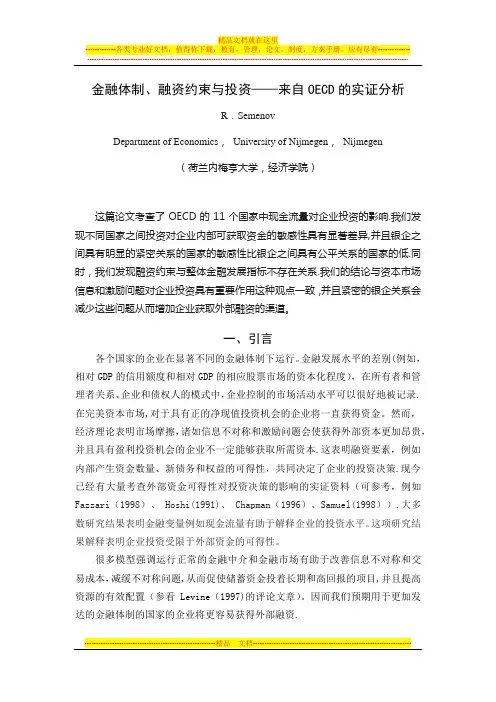
金融体制、融资约束与投资——来自OECD的实证分析R.SemenovDepartment of Economics,University of Nijmegen,Nijmegen(荷兰内梅亨大学,经济学院)这篇论文考查了OECD的11个国家中现金流量对企业投资的影响.我们发现不同国家之间投资对企业内部可获取资金的敏感性具有显著差异,并且银企之间具有明显的紧密关系的国家的敏感性比银企之间具有公平关系的国家的低.同时,我们发现融资约束与整体金融发展指标不存在关系.我们的结论与资本市场信息和激励问题对企业投资具有重要作用这种观点一致,并且紧密的银企关系会减少这些问题从而增加企业获取外部融资的渠道。
一、引言各个国家的企业在显著不同的金融体制下运行。
金融发展水平的差别(例如,相对GDP的信用额度和相对GDP的相应股票市场的资本化程度),在所有者和管理者关系、企业和债权人的模式中,企业控制的市场活动水平可以很好地被记录.在完美资本市场,对于具有正的净现值投资机会的企业将一直获得资金。
然而,经济理论表明市场摩擦,诸如信息不对称和激励问题会使获得外部资本更加昂贵,并且具有盈利投资机会的企业不一定能够获取所需资本.这表明融资要素,例如内部产生资金数量、新债务和权益的可得性,共同决定了企业的投资决策.现今已经有大量考查外部资金可得性对投资决策的影响的实证资料(可参考,例如Fazzari(1998)、 Hoshi(1991)、 Chapman(1996)、Samuel(1998)).大多数研究结果表明金融变量例如现金流量有助于解释企业的投资水平。
这项研究结果解释表明企业投资受限于外部资金的可得性。
很多模型强调运行正常的金融中介和金融市场有助于改善信息不对称和交易成本,减缓不对称问题,从而促使储蓄资金投着长期和高回报的项目,并且提高资源的有效配置(参看Levine(1997)的评论文章)。
因而我们预期用于更加发达的金融体制的国家的企业将更容易获得外部融资.几位学者已经指出建立企业和金融中介机构可进一步缓解金融市场摩擦。
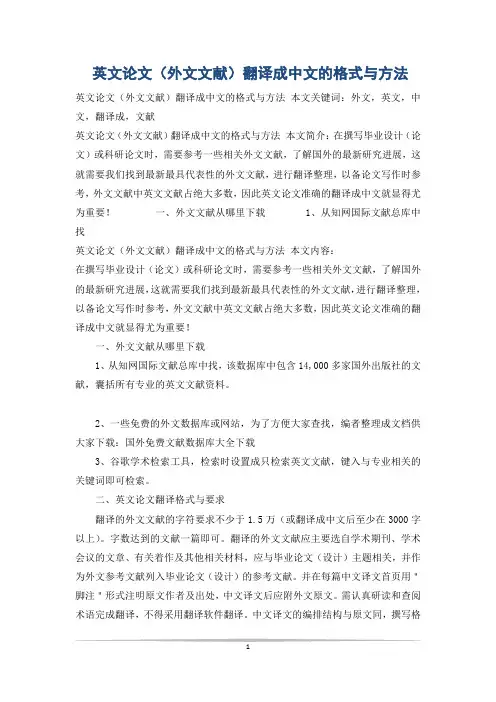
英文论文(外文文献)翻译成中文的格式与方法英文论文(外文文献)翻译成中文的格式与方法本文关键词:外文,英文,中文,翻译成,文献英文论文(外文文献)翻译成中文的格式与方法本文简介:在撰写毕业设计(论文)或科研论文时,需要参考一些相关外文文献,了解国外的最新研究进展,这就需要我们找到最新最具代表性的外文文献,进行翻译整理,以备论文写作时参考,外文文献中英文文献占绝大多数,因此英文论文准确的翻译成中文就显得尤为重要!一、外文文献从哪里下载1、从知网国际文献总库中找英文论文(外文文献)翻译成中文的格式与方法本文内容:在撰写毕业设计(论文)或科研论文时,需要参考一些相关外文文献,了解国外的最新研究进展,这就需要我们找到最新最具代表性的外文文献,进行翻译整理,以备论文写作时参考,外文文献中英文文献占绝大多数,因此英文论文准确的翻译成中文就显得尤为重要!一、外文文献从哪里下载1、从知网国际文献总库中找,该数据库中包含14,000多家国外出版社的文献,囊括所有专业的英文文献资料。
2、一些免费的外文数据库或网站,为了方便大家查找,编者整理成文档供大家下载:国外免费文献数据库大全下载3、谷歌学术检索工具,检索时设置成只检索英文文献,键入与专业相关的关键词即可检索。
二、英文论文翻译格式与要求翻译的外文文献的字符要求不少于1.5万(或翻译成中文后至少在3000字以上)。
字数达到的文献一篇即可。
翻译的外文文献应主要选自学术期刊、学术会议的文章、有关着作及其他相关材料,应与毕业论文(设计)主题相关,并作为外文参考文献列入毕业论文(设计)的参考文献。
并在每篇中文译文首页用"脚注"形式注明原文作者及出处,中文译文后应附外文原文。
需认真研读和查阅术语完成翻译,不得采用翻译软件翻译。
中文译文的编排结构与原文同,撰写格式参照毕业论文的格式要求。
参考文献不必翻译,直接使用原文的(字体,字号,标点符号等与毕业论文中的参考文献要求同),参考文献的序号应标注在译文中相应的地方。
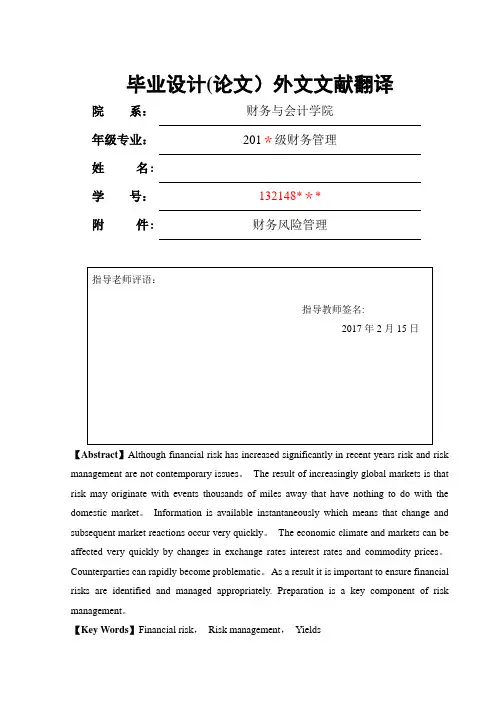
毕业设计(论文)外文文献翻译院系:财务与会计学院年级专业:201*级财务管理姓名:学号:132148***附件: 财务风险管理【Abstract】Although financial risk has increased significantly in recent years risk and risk management are not contemporary issues。
The result of increasingly global markets is that risk may originate with events thousands of miles away that have nothing to do with the domestic market。
Information is available instantaneously which means that change and subsequent market reactions occur very quickly。
The economic climate and markets can be affected very quickly by changes in exchange rates interest rates and commodity prices。
Counterparties can rapidly become problematic。
As a result it is important to ensure financial risks are identified and managed appropriately. Preparation is a key component of risk management。
【Key Words】Financial risk,Risk management,YieldsI. Financial risks arising1.1What Is Risk1.1.1The concept of riskRisk provides the basis for opportunity. The terms risk and exposure have subtle differences in their meaning. Risk refers to the probability of loss while exposure is the possibility of loss although they are often used interchangeably。
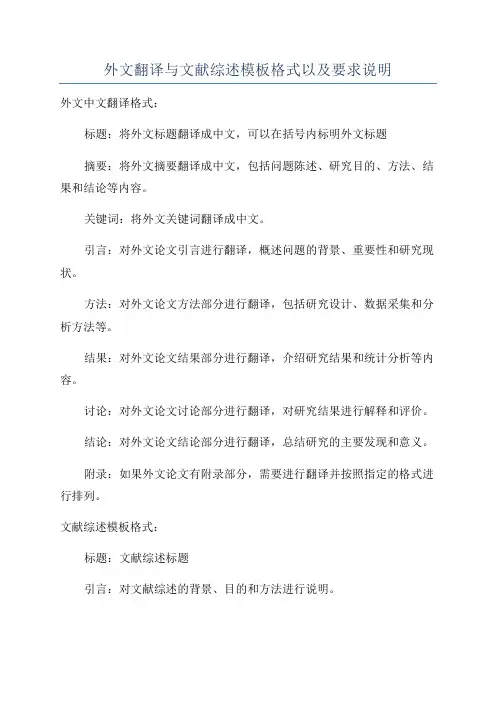
外文翻译与文献综述模板格式以及要求说明
外文中文翻译格式:
标题:将外文标题翻译成中文,可以在括号内标明外文标题
摘要:将外文摘要翻译成中文,包括问题陈述、研究目的、方法、结果和结论等内容。
关键词:将外文关键词翻译成中文。
引言:对外文论文引言进行翻译,概述问题的背景、重要性和研究现状。
方法:对外文论文方法部分进行翻译,包括研究设计、数据采集和分析方法等。
结果:对外文论文结果部分进行翻译,介绍研究结果和统计分析等内容。
讨论:对外文论文讨论部分进行翻译,对研究结果进行解释和评价。
结论:对外文论文结论部分进行翻译,总结研究的主要发现和意义。
附录:如果外文论文有附录部分,需要进行翻译并按照指定的格式进行排列。
文献综述模板格式:
标题:文献综述标题
引言:对文献综述的背景、目的和方法进行说明。
综述内容:按照时间、主题或方法等进行分类,对相关文献进行综述,可以分段进行描述。
讨论:对综述内容进行解释和评价,概括主要研究成果和趋势。
结论:总结文献综述,概括主要发现和意义。
要求说明:
1.外文中文翻译要准确无误,语句通顺流畅,做到质量高、符合学术
规范。
2.文献综述要选择与所研究领域相关的文献进行综述,覆盖面要广,
内容要全面、准确并有独立思考。
4.文献综述要注重整体结构和逻辑连贯性,内容要有层次感,段落间
要过渡自然。
5.外文中文翻译和文献综述要进行查重,确保原文与译文的一致性,
并避免抄袭和剽窃行为。
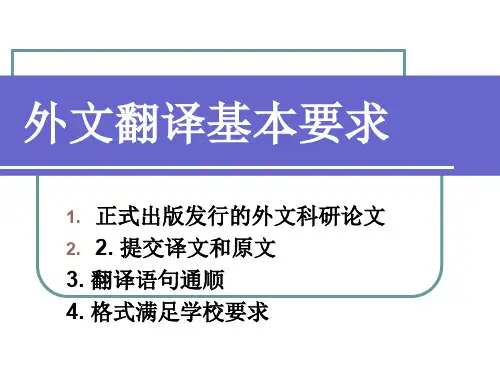
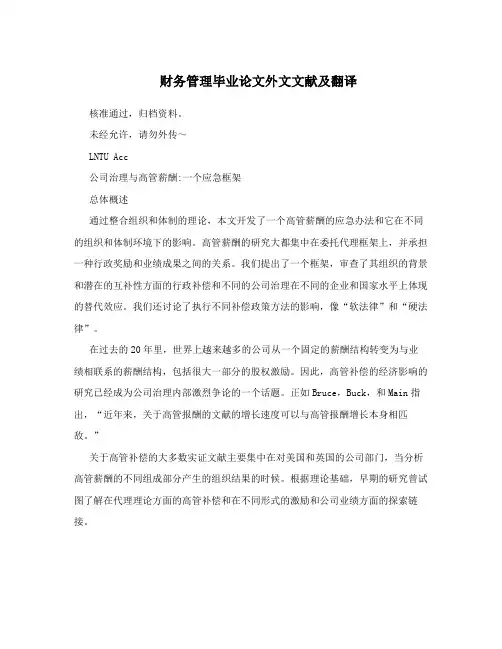
财务管理毕业论文外文文献及翻译核准通过,归档资料。
未经允许,请勿外传~LNTU Acc公司治理与高管薪酬:一个应急框架总体概述通过整合组织和体制的理论,本文开发了一个高管薪酬的应急办法和它在不同的组织和体制环境下的影响。
高管薪酬的研究大都集中在委托代理框架上,并承担一种行政奖励和业绩成果之间的关系。
我们提出了一个框架,审查了其组织的背景和潜在的互补性方面的行政补偿和不同的公司治理在不同的企业和国家水平上体现的替代效应。
我们还讨论了执行不同补偿政策方法的影响,像“软法律”和“硬法律”。
在过去的20年里,世界上越来越多的公司从一个固定的薪酬结构转变为与业绩相联系的薪酬结构,包括很大一部分的股权激励。
因此,高管补偿的经济影响的研究已经成为公司治理内部激烈争论的一个话题。
正如Bruce,Buck,和Main指出,“近年来,关于高管报酬的文献的增长速度可以与高管报酬增长本身相匹敌。
”关于高管补偿的大多数实证文献主要集中在对美国和英国的公司部门,当分析高管薪酬的不同组成部分产生的组织结果的时候。
根据理论基础,早期的研究曾试图了解在代理理论方面的高管补偿和在不同形式的激励和公司业绩方面的探索链接。
这个文献假设,股东和经理人之间的委托代理关系被激发,公司将更有效率的运作,表现得更好。
公司治理的研究大多是基于通用模型——委托代理理论的概述,以及这一框架的核心前提是,股东和管理人员有不同的方法来了解公司的具体信息和广泛的利益分歧以及风险偏好。
因此,经理作为股东的代理人可以从事对自己有利的行为而损害股东财富的最大化。
大量的文献是基于这种直接的前提和建议来约束经理的机会主义行为,股东可以使用不同的公司治理机制,包括各种以股票为基础的奖励可以统一委托人和代理人的利益。
正如Jensen 和Murphy观察,“代理理论预测补偿政策将会以满足代理人的期望效用为主要目标。
股东的目标是使财富最大化;因此代理成本理论指出,总裁的薪酬政策将取决于股东财富的变化。
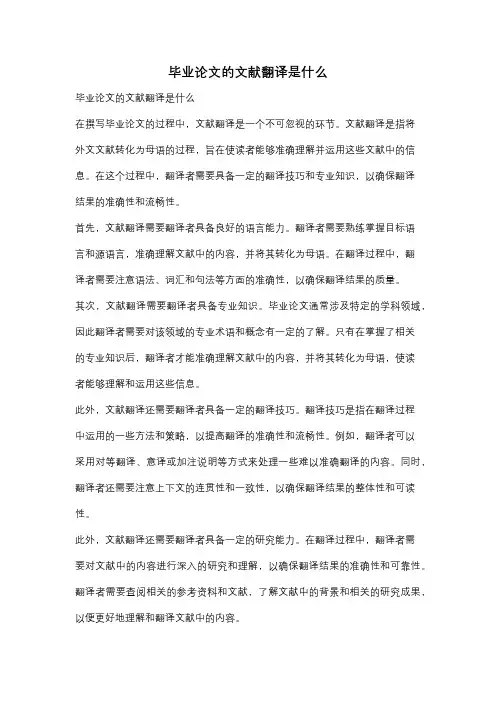
毕业论文的文献翻译是什么毕业论文的文献翻译是什么在撰写毕业论文的过程中,文献翻译是一个不可忽视的环节。
文献翻译是指将外文文献转化为母语的过程,旨在使读者能够准确理解并运用这些文献中的信息。
在这个过程中,翻译者需要具备一定的翻译技巧和专业知识,以确保翻译结果的准确性和流畅性。
首先,文献翻译需要翻译者具备良好的语言能力。
翻译者需要熟练掌握目标语言和源语言,准确理解文献中的内容,并将其转化为母语。
在翻译过程中,翻译者需要注意语法、词汇和句法等方面的准确性,以确保翻译结果的质量。
其次,文献翻译需要翻译者具备专业知识。
毕业论文通常涉及特定的学科领域,因此翻译者需要对该领域的专业术语和概念有一定的了解。
只有在掌握了相关的专业知识后,翻译者才能准确理解文献中的内容,并将其转化为母语,使读者能够理解和运用这些信息。
此外,文献翻译还需要翻译者具备一定的翻译技巧。
翻译技巧是指在翻译过程中运用的一些方法和策略,以提高翻译的准确性和流畅性。
例如,翻译者可以采用对等翻译、意译或加注说明等方式来处理一些难以准确翻译的内容。
同时,翻译者还需要注意上下文的连贯性和一致性,以确保翻译结果的整体性和可读性。
此外,文献翻译还需要翻译者具备一定的研究能力。
在翻译过程中,翻译者需要对文献中的内容进行深入的研究和理解,以确保翻译结果的准确性和可靠性。
翻译者需要查阅相关的参考资料和文献,了解文献中的背景和相关的研究成果,以便更好地理解和翻译文献中的内容。
最后,文献翻译还需要翻译者具备一定的时间管理能力。
毕业论文的撰写通常有严格的时间要求,因此翻译者需要合理安排时间,确保在规定的时间内完成文献翻译的任务。
同时,翻译者还需要预留一定的时间进行校对和修改,以确保翻译结果的质量。
综上所述,毕业论文的文献翻译是一个需要翻译者具备一定的语言能力、专业知识、翻译技巧、研究能力和时间管理能力的过程。
只有在具备这些能力的基础上,翻译者才能准确理解和翻译文献中的内容,并将其转化为母语,使读者能够准确理解并运用这些信息。
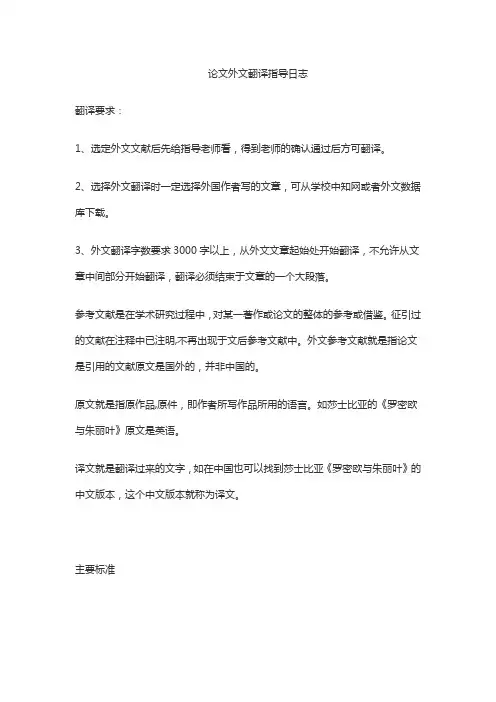
论文外文翻译指导日志
翻译要求:
1、选定外文文献后先给指导老师看,得到老师的确认通过后方可翻译。
2、选择外文翻译时一定选择外国作者写的文章,可从学校中知网或者外文数据库下载。
3、外文翻译字数要求3000字以上,从外文文章起始处开始翻译,不允许从文章中间部分开始翻译,翻译必须结束于文章的一个大段落。
参考文献是在学术研究过程中,对某一著作或论文的整体的参考或借鉴。
征引过的文献在注释中已注明,不再出现于文后参考文献中。
外文参考文献就是指论文是引用的文献原文是国外的,并非中国的。
原文就是指原作品,原件,即作者所写作品所用的语言。
如莎士比亚的《罗密欧与朱丽叶》原文是英语。
译文就是翻译过来的文字,如在中国也可以找到莎士比亚《罗密欧与朱丽叶》的中文版本,这个中文版本就称为译文。
主要标准
翻译是语际交流过程中沟通不同语言的桥梁。
一般来说,翻译的标准主要有两条:忠实和通顺。
忠实
是指忠实于原文所要传递的信息,也就是说,把原文的信息完整并且准确地表达出来,使译文读者得到的信息与原文读者得到的信息大致相同。
通顺
是指译文规范、明白易懂,没有文理不通、结构混乱、逻辑不清的现象。
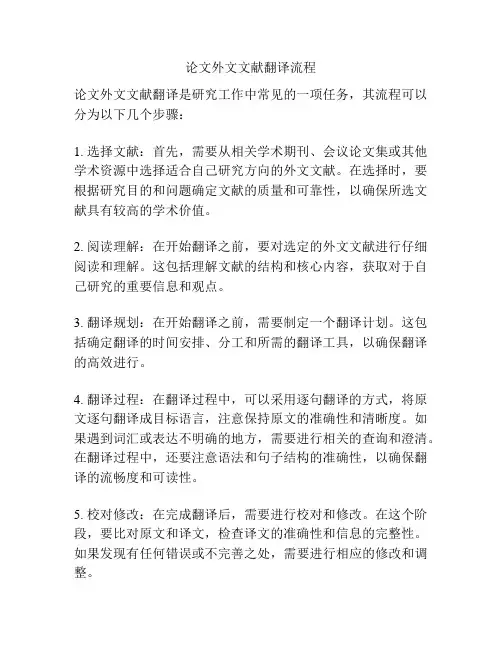
论文外文文献翻译流程论文外文文献翻译是研究工作中常见的一项任务,其流程可以分为以下几个步骤:1. 选择文献:首先,需要从相关学术期刊、会议论文集或其他学术资源中选择适合自己研究方向的外文文献。
在选择时,要根据研究目的和问题确定文献的质量和可靠性,以确保所选文献具有较高的学术价值。
2. 阅读理解:在开始翻译之前,要对选定的外文文献进行仔细阅读和理解。
这包括理解文献的结构和核心内容,获取对于自己研究的重要信息和观点。
3. 翻译规划:在开始翻译之前,需要制定一个翻译计划。
这包括确定翻译的时间安排、分工和所需的翻译工具,以确保翻译的高效进行。
4. 翻译过程:在翻译过程中,可以采用逐句翻译的方式,将原文逐句翻译成目标语言,注意保持原文的准确性和清晰度。
如果遇到词汇或表达不明确的地方,需要进行相关的查询和澄清。
在翻译过程中,还要注意语法和句子结构的准确性,以确保翻译的流畅度和可读性。
5. 校对修改:在完成翻译后,需要进行校对和修改。
在这个阶段,要比对原文和译文,检查译文的准确性和信息的完整性。
如果发现有任何错误或不完善之处,需要进行相应的修改和调整。
6. 审稿意见:在完成校对修改后,可以邀请一些专业人士或同行进行审稿。
他们可以对翻译的准确性和语言的表达提出宝贵的意见和建议,以进一步提高翻译质量。
7. 格式调整:在翻译完成后,需要对文献进行格式调整。
这包括调整字体、段落、标点和引用等格式,以符合目标语言的学术写作要求。
8. 最终定稿:最后一步是最终定稿,将翻译后的外文文献整理成最终的版本。
在这个阶段,要检查文献的所有细节,确保没有任何错误和遗漏。
整个外文文献翻译流程需要仔细和耐心地进行,以确保翻译的准确性和质量。
熟悉外文学术规范和术语的使用是提高翻译效果的关键。
并且,要合理利用翻译工具和辅助资源,提高翻译的效率和准确性。
最终的翻译成果将为研究工作提供重要的支持和参考。
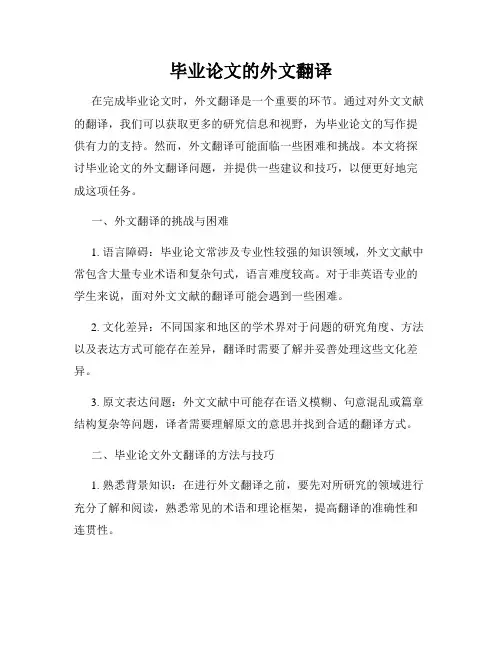
毕业论文的外文翻译在完成毕业论文时,外文翻译是一个重要的环节。
通过对外文文献的翻译,我们可以获取更多的研究信息和视野,为毕业论文的写作提供有力的支持。
然而,外文翻译可能面临一些困难和挑战。
本文将探讨毕业论文的外文翻译问题,并提供一些建议和技巧,以便更好地完成这项任务。
一、外文翻译的挑战与困难1. 语言障碍:毕业论文常涉及专业性较强的知识领域,外文文献中常包含大量专业术语和复杂句式,语言难度较高。
对于非英语专业的学生来说,面对外文文献的翻译可能会遇到一些困难。
2. 文化差异:不同国家和地区的学术界对于问题的研究角度、方法以及表达方式可能存在差异,翻译时需要了解并妥善处理这些文化差异。
3. 原文表达问题:外文文献中可能存在语义模糊、句意混乱或篇章结构复杂等问题,译者需要理解原文的意思并找到合适的翻译方式。
二、毕业论文外文翻译的方法与技巧1. 熟悉背景知识:在进行外文翻译之前,要先对所研究的领域进行充分了解和阅读,熟悉常见的术语和理论框架,提高翻译的准确性和连贯性。
2. 通过多种途径获取资料:除了查阅相关的外文文献,还可以通过学术数据库、专业期刊和学术社区等获取更多的翻译参考资料。
3. 注意审视文本:在翻译过程中,要仔细审视原文,并理解作者的意图和表达方式。
对于一些存在歧义的句子或术语,可以通过查阅其他资料或与同行交流来进行准确的翻译。
4. 日常积累与翻译软件的使用:通过积累英文词汇量和阅读经验,增强对外文翻译的灵活运用。
同时,在需要的时候可以借助翻译软件进行辅助翻译,但需要注意避免直接将翻译软件的结果作为最终翻译。
5. 注意文化差异:在进行外文翻译时,要注意不同文化背景下的表达差异。
对于无法准确翻译的文化特定词汇或短语,可以使用括号注释或提供解释等方式进行说明。
三、毕业论文外文翻译的注意事项1. 保持准确性:翻译过程中要保持准确性,尽可能地忠实表达原文的意思,不要随意增加或删除信息。
另外,要根据具体的学术规范和格式要求进行文献引用和注释。
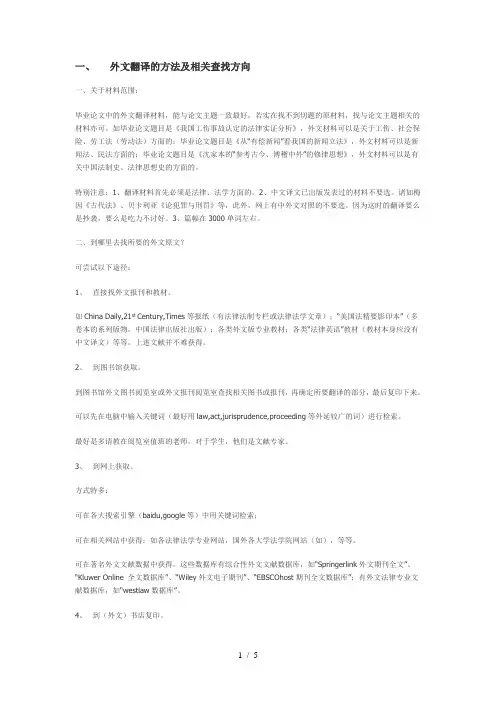
一、外文翻译的方法及相关查找方向一、关于材料范围:毕业论文中的外文翻译材料,能与论文主题一致最好,若实在找不到切题的原材料,找与论文主题相关的材料亦可。
如毕业论文题目是《我国工伤事故认定的法律实证分析》,外文材料可以是关于工伤、社会保险、劳工法(劳动法)方面的;毕业论文题目是《从“有偿新闻”看我国的新闻立法》,外文材料可以是新闻法、民法方面的;毕业论文题目是《沈家本的“参考古今、博稽中外”的修律思想》,外文材料可以是有关中国法制史、法律思想史的方面的。
特别注意:1、翻译材料首先必须是法律、法学方面的。
2、中文译文已出版发表过的材料不要选。
诸如梅因《古代法》、贝卡利亚《论犯罪与刑罚》等,此外,网上有中外文对照的不要选。
因为这时的翻译要么是抄袭,要么是吃力不讨好。
3、篇幅在3000单词左右。
二、到哪里去找所要的外文原文?可尝试以下途径:1、直接找外文报刊和教材。
如China Daily,21st Century,Times等报纸(有法律法制专栏或法律法学文章);“美国法精要影印本”(多卷本的系列版物,中国法律出版社出版);各类外文版专业教材;各类“法律英语”教材(教材本身应没有中文译文)等等。
上述文献并不难获得。
2、到图书馆获取。
到图书馆外文图书阅览室或外文报刊阅览室查找相关图书或报刊,再确定所要翻译的部分,最后复印下来。
可以先在电脑中输入关键词(最好用law,act,jurisprudence,proceeding等外延较广的词)进行检索。
最好是多请教在阅览室值班的老师,对于学生,他们是文献专家。
3、到网上获取。
方式特多:可在各大搜索引擎(baidu,google等)中用关键词检索;可在相关网站中获得:如各法律法学专业网站,国外各大学法学院网站(如),等等。
可在著名外文文献数据中获得。
这些数据库有综合性外文文献数据库,如“Springerlink外文期刊全文”、“Kluwer Online 全文数据库”、“Wiley外文电子期刊”、“EBSCOhost期刊全文数据库”;有外文法律专业文献数据库,如“westlaw数据库”。
毕业论文的外文翻译是什么在如今全球化的时代,毕业论文的外文翻译变得越来越重要。
由于不同学术领域与研究主题在全球范围内的广泛交流,外文文献往往成为毕业论文写作的重要参考资源。
毕业论文的外文翻译不仅能够扩充研究数据来源,还能加深理解并对比国内外研究现状以提升研究质量。
本文将探讨毕业论文的外文翻译的定义、目的以及相关注意事项。
外文翻译的定义和目的毕业论文的外文翻译是指将英语、法语、德语、俄语或其他外文献的内容翻译成中文的过程。
它的目的是使学术研究者能够更好地理解和应用外文文献,以支撑他们的研究工作。
通过对外文献的翻译,学术界可以顺利进行国际交流与合作,拓宽知识视野。
研究者也能为毕业论文提供全球范围内的最新研究成果,提高论文的学术水平。
注意事项在进行毕业论文的外文翻译时,以下几个注意事项应牢记于心:1.准确性和可信性:翻译的准确性和可信性是首要关注的问题。
翻译者必须确保所翻译的内容与原文的意思保持一致,并尽量使用准确和专业的词汇。
对于生僻词汇或特定领域的术语,可以借助专业工具或咨询相关领域的专家以确保翻译的准确性。
2.语言风格的调整:毕业论文的外文翻译需要根据中文写作的习惯和规范进行语言风格的调整。
例如,外文中可能使用了复杂的句子结构或文化隐喻,翻译时应尽量使用简明清晰的中文表达,以确保读者能够准确理解研究内容。
3.文化背景的融入:语言与文化密不可分。
在外文翻译过程中,翻译者需要了解原文所处的文化背景,并适当融入到翻译中。
这样才能确保翻译的内容在目标文化中具有更好的可读性和可理解性。
4.保护原文作者的权益:毕业论文的外文翻译要尊重并保护原文作者的权益。
在翻译时,应注明原文出处,以遵守学术诚信规范,并尽量避免篡改、删减或误解原文的意思。
如果有需要,可以适度加入个人的理解或注释,但必须清晰标注为个人观点。
5.翻译工具的利用:在进行毕业论文的外文翻译时,可以利用翻译工具辅助翻译。
然而,机器翻译并不能完全取代人工翻译的重要性。
毕业设计论文化学系毕业论文外文文献翻译中英文英文文献及翻译A chemical compound that is contained in the hands of the problemsfor exampleCatalytic asymmetric carbon-carbon bond formation is one of the most active research areas in organic synthesis In this field the application of chiral ligands in enantioselective addition of diethylzinc to aldehydes has attracted much attention lots of ligands such as chiral amino alcohols amino thiols piperazines quaternary ammonium salts 12-diols oxazaborolidines and transition metal complex with chiral ligands have been empolyed in the asymmetric addition of diethylzinc to aldehydes In this dissertation we report some new chiral ligands and their application in enantioselective addition of diethylzinc to aldehydes1 Synthesis and application of chiral ligands containing sulfur atomSeveral a-hydroxy acids were prepared using the literature method with modifications from the corresponding amino acids valine leucine and phenylalanine Improved yields were obtained by slowly simultaneous addition of three fold excess of sodium nitrite and 1 tnolL H2SO4 In the preparation of a-hydroxy acid methyl esters from a-hydroxy acids following the procedure described by Vigneron a low yield 45 was obtained It was found that much better results yield 82 couldbe obtained by esterifying a-hydroxy acids with methanol-thionyl chlorideThe first attempt to convert S -2-hydroxy-3-methylbutanoic acid methyl ester to the corresponding R-11-diphenyl-2-mercapto-3-methyl-l-butanol is as the following S-2-Hydroxy-3-methylbutanoic acid methyl ester was treated with excess of phenylmagnesium bromide to give S -11-diphenyl-3-methyl-12-butanediol which was then mesylated to obtain S -11-diphenyl-3-methyl-2-methanesulfonyloxy -l-butanol Unfortunately conversion of S-11-diphenyl-3-methyl-2- methanesulfonyloxy -l-butanol to the corresponding thioester by reacting with potassium thioacetate under Sn2 reaction conditions can be achieved neither in DMF at 20-60 nor in refluxing toluene in the presence of 18-crown-6 as catalyst When S -1ll-diphenyl-3-methyl-2- methane sulfonyloxy -l-butanol was refluxed with thioacetic acid in pyridine an optical active epoxide R-22-diphenyl -3-isopropyloxirane was obtained Then we tried to convert S -11-diphenyl-3-methyl-l2-butanediol to the thioester by reacting with PPh3 DEAD and thioacetic acid the Mitsunobu reaction but we failed either probably due to the steric hindrance around the reaction centerThe actually successful synthesis is as described below a-hydroxy acid methyl esters was mesylated and treated with KSCOCH3 in DMF to give thioester this was than treated with phenyl magnesium bromide to gave the target compound B-mercaptoalcohols The enantiomeric excesses ofp-mercaptoalcohols can be determined by 1H NMR as their S -mandeloyl derivatives S -2-amino-3-phenylpropane-l-thiol hydrochloride was synthesized from L-Phenylalanine L-Phenylalanine was reduced to the amino alcohol S -2-amino-3-phenylpropanol Protection of the amino group using tert-butyl pyrocarbonate gave S -2-tert-butoxycarbonylamino-3-phenylpropane-l-ol which was then O-mesylated to give S -2-tert-butoxycarbonylamino-3-phenylpropyl methanesulfonate The mesylate was treated with potassium thioacetate in DMF to give l-acetylthio-2-tert-butoxycarbonylamino-3-phenylpropane The acetyl group was then removed by treating with ammonia in alcohol to gave S -2-tert-butoxycarbonylamino-3-phenyl-propane-l-thiol which was then deprotected with hydrochloric acid to give the desired S-2-amino-3-phenylpropane-1-thiol hydrochlorideThe enantioselective addition of diethylzinc to aldehydes promoted by these sulfur containing chiral ligands produce secondary alcohols in 65-79 Synthesis and application of chiral aminophenolsThree substituted prolinols were prepared from the naturally-occurring L-proline using reported method with modifications And the chiral aminophenols were obtained by heating these prolinols with excess of salicylaldehyde in benzene at refluxThe results of enantioselective adBelow us an illustration forexampleN-Heterocyclic carbenes and L-Azetidine-2-carboxylicacidN-Heterocyclic carbenesN-Heterocyclic carbenes have becomeuniversal ligands in organometallic and inorganic coordination chemistry They not only bind to any transition metal with low or high oxidation states but also to main group elements such as beryllium sulfur and iodine Because of their specific coordination chemistry N-heterocyclic carbenes both stabilize and activate metal centers in quite different key catalytic steps of organic syntheses for example C-H activation C-C C-H C-O and C-N bond formation There is now ample evidence that in the new generation of organometallic catalysts the established ligand class of organophosphanes will be supplemented and in part replaced byN-heterocyclic carbenes Over the past few years this chemistry has become the field of vivid scientific competition and yielded previously unexpected successes in key areas of homogeneous catalysis From the work in numerous academic laboratories and in industry a revolutionary turningpoint in oraganometallic catalysis is emergingIn this thesis Palladium Ⅱ acetate and NN"-bis- 26-diisopropylphenyl dihydro- imidazolium chloride 1 2 mol were used to catalyze the carbonylative coupling of aryl diazonium tetrafluoroborate salts and aryl boronic acids to form aryl ketones Optimal conditions include carbon monoxide 1 atm in 14-dioxane at 100℃ for 5 h Yields for unsymmetrical aryl ketones ranged from 76 to 90 for isolated materials with only minor amounts of biaryl coupling product observed 2-12 THF as solvent gave mixtures of products 14-Dioxane proved to be the superior solvent giving higher yieldsof ketone product together with less biphenyl formation At room temperature and at 0℃ with 1 atm CO biphenyl became the major product Electron-rich diazonium ion substrates gave a reduced yield with increased production of biaryl product Electron-deficient diazonium ions were even better forming ketones in higher yields with less biaryl by-product formed 2-Naphthyldiazonium salt also proved to be an effective substrate givingketones in the excellent range Base on above palladium NHC catalysts aryl diazonium tetrafluoroborates have been coupled with arylboron compounds carbon monoxide and ammonia to give aryl amides in high yields A saturated yV-heterocyclic carbene NHC ligand H2lPr 1 was used with palladium II acetate to give the active catalyst The optimal conditions with 2mol palladium-NHC catalyst were applied with various organoboron compounds and three aryl diazonium tetrafluoroborates to give numerous aryl amides in high yield using pressurized CO in a THF solution saturated with ammonia Factors that affect the distribution of the reaction products have been identified and a mechanism is proposed for this novel four-component coupling reactionNHC-metal complexes are commonly formed from an imidazolium salt using strong base Deprotonation occurs at C2 to give a stable carbene that adds to form a a-complex with the metal Crystals were obtained from the reaction of imidazolium chloride with sodium t- butoxide Nal and palladium II acetate giving a dimeric palladium II iodide NHC complex The structure adopts a flat 4-memberedring u2 -bridged arrangement as seen in a related dehydro NHC complex formed with base We were pleased to find that chloride treated with palladium II acetate without adding base or halide in THF also produced suitable crystals for X-ray anaysis In contrast to the diiodide the palladium-carbenes are now twisted out of plane adopting a non-planar 4-ring core The borylation of aryldiazonium tetrafluoroborates with bis pinacolatoborane was optimized using various NHC ligand complexes formed in situ without adding base NN"-Bis 26-diisopropylphenyl-45-dihydroimidazolium 1 used with palladium acetate in THF proved optimal giving borylated product in 79 isolated yield without forming of bi-aryl side product With K2CO3 and ligand 1 a significant amount of biaryl product 24 was again seen The characterization of the palladium chloride complex by X-ray chrastallography deL-Azetidine-2-carboxylic acidL-Azetidine-2-carboxylic acid also named S -Azetidine-2-carboxylic acid commonly named L-Aze was first isolated in 1955 by Fowden from Convallaria majalis and was the first known example of naturally occurring azetidine As a constrained amino acid S -Azetidine-2-carboxylic acid has found many applications in the modification of peptides conformations and in the area of asymmetric synthesis which include its use in the asymmetric reduction of ketones Michael additions cyclopropanations and Diels-Alder reactions In this dissertation five ways for synthesize S-Azetidine-2-carboxylic acid were studied After comparing all methods theway using L-Aspartic acid as original material for synthesize S-Azetidine-2-carboxylic acid was considered more feasible All mechanisms of the way"s reaction have also been studied At last the application and foreground of S -Azetidine-2-carboxylic acid were viewed The structures of the synthetic products were characterized by ThermalGravity-Differential Thermal Analysis TG-DTA Infrared Spectroscopy IR Mass Spectra MS and 1H Nuclear Magnetic Resonance 1H-NMR Results showed that the structures and performances of the products conformed to the anticipation the yield of each reaction was more than 70 These can conclude that the way using L-Aspartie acid as original material for synthesize S -Azetidine-2-carboxylic acid is practical and effective杂环化合物生成中包含手性等问题如催化形成不对称碳碳键在有机合成中是一个非常活跃的领域在这个领域中利用手性配体诱导的二乙基锌和醛的不对称加成引起化学家的广泛关注许多手性配体如手性氨基醇手性氨基硫醇手性哌嗪手性四季铵盐手性二醇手性恶唑硼烷和过渡金属与手性配体的配合物等被应用于二乙基锌对醛的不对称加成中在本论文中我们报道了一些新型的手性配体的合成及它们应用于二乙基锌对醛的不对称加成的结果1含硫手性配体的合成和应用首先从氨基酸缬氨酸亮氨酸苯丙氨酸出发按照文献合成α-羟基酸并发现用三倍量的亚硝酸钠和稀硫酸同时滴加进行反应能适当提高反应的产率而根据Vigneron等人报道的的方法用浓盐酸催化从α-羟基酸合成α-羟基酸甲酯时只能获得较低的产率改用甲醇-二氯亚砜的酯化方法时能提高该步骤的产率从 S -3-甲基-2-羟基丁酸甲酯合成 R -3-甲基-11-二苯基-2-巯基-1-丁醇经过了以下的尝试 S -3-甲基-2-羟基丁酸甲酯和过量的格氏试剂反应得到 S -3-甲基-11-二苯基-12-丁二醇进行甲磺酰化时位阻较小的羟基被磺酰化生成 S -3-甲基-11-二苯基-2- 甲磺酰氧基 -1-丁醇但无论将 S -3-甲基-11-二苯基-2- 甲磺酰氧基 -1-丁醇和硫代乙酸钾在DMF中反应 20~60℃还是在甲苯中加入18-冠-6作为催化剂加热回流都不能得到目标产物当其与硫代乙酸在吡啶中回流时得到的不是目标产物而是手性环氧化合物 R -3-异丙基-22-二苯基氧杂环丙烷从化合物 S -3-甲基-11-二苯基-12-丁二醇通过Mitsunobu反应合成硫代酯也未获得成功这可能是由于在反应中心处的位阻较大造成的几奥斯塑手村犯体的合成裁其在不对称奋成中肠左用摘要成功合成疏基醇的合成路是将a-轻基酸甲酷甲磺酞化得到相应的磺酞化产物并进行与硫代乙酸钾的亲核取代反应得到硫酷进行格氏反应后得到目标分子p一疏基醇用p一疏基醇与 R 义一一甲氧基苯乙酞氯生成的非对映体经H侧NM吸测试其甲氧基峰面积的积分求得其ee值 3一苯基一氨基丙硫醇盐酸盐从苯丙氨酸合成斗3一苯基一氨基丙醇由L一苯丙氨酸还原制备氨基保护后得到习一3一苯基一2一叔丁氧拨基氨基一1一丙醇甲磺酞化后得到习一3一苯基一2一叔丁氧拨基氨基一1一丙醇甲磺酸酷用硫代乙酸钾取代后得匀一3-苯基一2一叔丁氧拨基氨基一1一丙硫醇乙酸酷氨解得习一3一苯基一2一叔丁氧拨基氨基一1一丙硫醇用盐酸脱保护后得到目标产物扔3一苯基屯一氨基丙硫醇盐酸盐手性含硫配体诱导下的二乙基锌与醛的加成所得产物的产率为65一79值为O井92手性氨基酚的合成和应用首先从天然的L一脯氨酸从文献报道的步骤合成了三种脯氨醇这些手性氨基醇与水杨醛在苯中回流反应得到手性氨基酚手性氨基酚配体诱导下的二乙基锌与醛的加成所得产物的产率为45一98值为0一90手性二茂铁甲基氨基醇的合成和应用首先从天然氨基酸绿氨酸亮氨酸苯丙氨酸和脯氨酸合成相应的氨基醇这些氨基醇与二茂铁甲醛反应生成的NO一缩醛经硼氢化钠还原得到手性二茂铁甲基氨基醇手性二茂铁甲基氨基醇配体诱导下的二乙基锌与醛的加成所得产物的产率为66一97下面我们举例说明一下例如含氮杂环卡宾和L-氮杂环丁烷-2-羧酸含氮杂环卡宾含氮杂环卡宾已广泛应用于有机金属化学和无机配合物化学领域中它们不仅可以很好地与任何氧化态的过渡金属络合还可以与主族元素铍硫等形成配合物由于含氮杂环卡宾不但使金属中心稳定而且还可以活化此金属中心使其在有机合成中例如C-H键的活化C-CC-HC-O和C-N键形成反应中有着十分重要的催化效能现有的证据充分表明在新一代有机金属催化剂中含氮杂环卡宾不但对有机膦类配体有良好的互补作用而且在有些方面取代有机膦配体成为主角近年来含氮杂环卡宾及其配合物已成为非常活跃的研究领域在均相催化这一重要学科中取得了难以想象的成功所以含氮杂环卡宾在均相有机金属催化领域的研究工作很有必要深入地进行下去本文研究了乙酸钯和NN双 26-二异丙基苯基 -45-二氢咪唑氯化物1作为催化剂催化芳基四氟硼酸重氮盐与芳基硼酸的羰基化反应合成了一系列二芳基酮并对反应条件进行了优化使反应在常温常压下进行一个大气压的一氧化碳14-二氧杂环己烷作溶剂100℃反应5h 不同芳基酮的收率达7690仅有微量的联芳烃付产物 212 反应选择性良好当采用四氢呋喃或甲苯作溶剂时得到含较多副产物的混合物由此可以证明14-二氧杂环己烷是该反应最适宜的溶剂在室温或0℃与一个大气压的一氧化碳反应联芳烃变成主产物含供电子取代基的芳基重氮盐常常给出较低收率的二芳基酮而含吸电子取代基的芳基重氮盐却给出更高收率的二芳基酮及较少量的联芳烃付产物实验证明2-萘基重氮盐具有很好的反应活性和选择性总是得到优异的反应结果在此基础上由不同的芳基四氟硼酸重氮盐与芳基硼酸一氧化碳和氨气协同作用以上述含氮杂环卡宾作配体与乙酸钯生成的高活性含氮杂环卡宾钯催化剂催化较高收率地得到了芳基酰胺优化的反应条件是使用2mol的钯-H_2IPr 1五个大气压的一氧化碳以氨气饱和的四氢呋喃作溶剂由不同的有机硼化合物与三种芳基重氮盐的四组份偶联反应同时不仅对生成的多种产物进行了定 L-氮杂环丁烷-2-羧酸L-氮杂环丁烷-2-羧酸又称 S -氮杂环丁烷-2-羧酸简称为L-Aze1955年由Fowden从植物铃兰 Convallaria majalis 中分离得到成为第一个被证实的植物中天然存在的氮杂环丁烷结构作为一种非典型的氨基酸已经发现 S -氮杂环丁烷-2-羧酸可广泛用于对多肽结构的修饰以及诸如不对称的羰基还原Michael 加成环丙烷化和Diels-Alder反应等不对称合成中的多个领域本文通过对 S -氮杂环丁烷-2-羧酸合成路线的研究综述了五种可行的合成路线及方法通过比较选用以L-天冬氨酸为初始原料合成 S -氮杂环丁烷-2-羧酸的路线即通过酯化反应活泼氢保护格氏反应内酰胺化反应还原反应氨基保护氧化反应脱保护等反应来合成 S -氮杂环丁烷-2-羧酸分析了每步反应的机理并对 S -氮杂环丁烷-2-羧酸的应用及前景给予展望通过热分析红外质谱核磁等分析手段对合成的化合物的结构进行表征结果表明所得的产物符合目标产物所合成的化合物的结构性能指标与设计的目标要求一致每步反应的收率都在70%以上可以判定以L-天冬氨酸为初始原料合成 S -氮杂环丁烷的路线方案切实可行。
如何进行毕业论文的文献翻译与引用毕业论文的文献翻译与引用是在写作过程中必不可少的一环。
良好的文献翻译与引用能够提升论文的质量与价值,增强论文的可信度和学术性。
然而,很多同学在文献翻译与引用方面存在一定困惑。
本文将介绍如何进行毕业论文的文献翻译与引用,以期帮助大家在论文写作中更加准确地翻译和引用文献。
一、文献翻译文献翻译是指将外文文献翻译成目标语言,以便读者理解和使用。
在进行文献翻译时,我们需要注意以下几点:1. 选择合适的文献在选择翻译文献时,应根据自己的研究方向和论文题目,选择与之相关的文献进行翻译。
同时要注意选择权威、可靠的文献来源,以确保翻译结果的准确性和可信度。
2. 注重语言表达和用词准确在进行翻译时,要注重语言表达和用词准确。
句子结构要清晰,语意要准确传达。
避免直译和误译,要根据上下文和语境进行恰当的翻译。
3. 保持文献原义在翻译过程中,应努力保持文献的原意。
不要对原文进行任意删减、增加或歪曲,要完整地表达原文中的内容和观点。
二、文献引用文献引用是指在论文中援引他人已发表的相关文献,以支撑自己的观点和主张。
正确的文献引用是保证论文学术性的基础。
以下是对文献引用的一些建议:1. 选择合适的引用方式在选择引用方式时,可以根据引用的内容和篇幅来决定是否直接引用、间接引用还是引述。
直接引用是将他人的观点原封不动地引用过来,要使用引号并标注出处。
间接引用是在自己的观点中引用他人观点的大意,无需使用引号但必须标注出处。
引述是将他人的观点用自己的语言重新表达,并标注出处。
2. 准确标注引用来源在引用文献时,要准确标注引用来源的作者、标题、出版日期、页码等信息,并按照规范的引用格式进行排版。
常用的引用格式有APA、MLA、Chicago等,可以根据自己的学院或研究领域要求选择合适的引用格式。
3. 避免滥用他人观点在引用他人观点时要避免滥用,应确保引用的内容与自己的论点紧密相关,并正确解读和分析引用内容,避免引用内容脱离实际情况或被扭曲。
毕业设计/论文开题报告课题名称院系专业班姓名评分指导教师华中科技大学武昌分校毕业设计开题报告撰写要求1. 开题报告主要内容1)课题设计的目的和意义;2)课题设计的主要内容;3)设计方案;4)实施计划。
5)主要参考文献:不少于5篇,其中外文文献不少于1篇。
2.撰写开题报告时,所选课题的课题名称也不得多于25个汉字,课题设计份量要适当,设计中必须是自己的设计内容。
3. 开题报告的字数不少于2000字(艺术类专业不少于1000字),格式按《华中科技大学武昌分校本科毕业设计/论文撰写规范》的要求撰写。
4. 指导教师和责任单位必须审查签字。
5.开题报告单独装订,本附件为封面,后续表格请从网上下载并用A4纸打印后填写。
6. 此开题报告适用于全校各专业,部分特殊专业需要变更的,由所在系在基础上提出调整方案,报学校审批后执行。
华中科技大学武昌分校学生毕业设计开题报告毕业设计/论文外文文献翻译院系专业班级姓名原文出处评分指导教师华中科技大学武昌分校20 年月日毕业设计/论文外文文献翻译要求:1.外文文献翻译的内容应与毕业设计/论文课题相关。
2.外文文献翻译的字数:非英语专业学生应完成与毕业设计/论文课题内容相关的不少于2000汉字的外文文献翻译任务(其中,汉语言文学专业、艺术类专业不作要求),英语专业学生应完成不少于2000汉字的二外文献翻译任务。
格式按《华中科技大学武昌分校本科毕业设计/论文撰写规范》的要求撰写。
3.外文文献翻译附于开题报告之后:第一部分为译文,第二部分为外文文献原文,译文与原文均需单独编制页码(底端居中)并注明出处。
本附件为封面,封面上不得出现页码。
4.外文文献翻译原文由指导教师指定,同一指导教师指导的学生不得选用相同的外文原文。
华中科技大学武昌分校本科毕业设计/论文撰写规范毕业设计/论文是学生在教师的指导下经过调查研究、科学实验或工程设计,对所取得成果的科学表述,是学生毕业及学位资格认定的重要依据。
毕业设计外文文献及翻译毕业设计外文文献及翻译在进行毕业设计时,外文文献的阅读和翻译是一个非常重要的环节。
通过阅读外文文献,我们可以了解到最新的研究进展和学术观点,拓宽自己的知识视野。
同时,通过翻译外文文献,我们可以将这些宝贵的资料转化为自己的知识和理解,为自己的毕业设计提供有力的支持。
首先,阅读外文文献需要一定的技巧和方法。
在选择外文文献时,我们可以通过搜索引擎、学术数据库等途径来获取相关的文献资源。
在阅读时,我们可以先浏览摘要和关键词,了解文献的主要内容和研究方法。
然后,可以选择性地阅读引言和结论部分,获取文献的背景和主要结论。
如果对文献的内容感兴趣,可以进一步阅读方法和结果部分,了解研究的具体过程和实验结果。
在阅读外文文献时,我们还可以借助翻译工具和词典,帮助理解和翻译生词和难句,提高阅读效率。
其次,翻译外文文献需要一定的语言能力和翻译技巧。
在翻译过程中,我们要尽量保持原文的意思和风格,避免出现歧义和误解。
同时,要注意语法和词汇的准确性,确保翻译的流畅和自然。
在翻译时,我们可以先整体理解文献的主旨和结构,然后逐句逐段进行翻译。
在遇到难以理解或翻译的地方,可以查阅相关的参考资料和词典,提高翻译的准确性和质量。
在翻译外文文献时,我们还可以借助翻译软件和在线翻译平台,提高翻译的效率和准确性。
除了阅读和翻译外文文献,我们还可以通过写作和讨论来加深对外文文献的理解和应用。
在写作过程中,我们可以将阅读和翻译的内容整理成文章的结构和逻辑,形成自己的思路和观点。
通过讨论和交流,我们可以与他人分享自己的理解和观点,获取更多的反馈和建议。
通过写作和讨论,我们可以将外文文献的内容转化为自己的知识和理解,为自己的毕业设计提供有力的支持和论证。
总之,毕业设计外文文献的阅读和翻译是一个重要的环节。
通过阅读外文文献,我们可以了解最新的研究进展和学术观点,拓宽自己的知识视野;通过翻译外文文献,我们可以将这些宝贵的资料转化为自己的知识和理解,为自己的毕业设计提供有力的支持。
外文翻译英文原文RIVER DIVERSION1 GeneralOne of the characteristics of the river hydraulic schemes is the essential need in the course of the entire period of construction, to divert the river water from the dam site, i.e. to give passage to that water. This is ensured by means of a series of individual structures: temporary cofferdams, embankments, channels, and tunnels, as well as by utilizing the permanent works of the hydraulic scheme, temporarily, for this purpose, as well.In selecting the scheme for diverting, i.e. letting through, the construction waters, one must take account of: the hydrological, topographical, and geological, as well as the construction and economy conditions of the locality anticipated for construction, the utilization of the river in the course of construction and other water economy needs (navigation, rafting, and floating of logs), etc. A poor solution for giving passage to the construction water leads to slowing down the construction of the hydraulic scheme, while the danger of damage is increased.Depending on the width of the river at thedam site and the quantity of construction water,in the course of construction of the hydraulicscheme the river waters can be evacuated in twomain ways: multistage construction andsingle-stage construction.2 Diversion methods(1) Single-stage methodThe method of construction of structures by means of diversion of the river from the river channel is usually employed with narrow river channels, as well as with steep banks during the construction of hydraulic schemes with a medium and with a high-pressure head. In the first place, the water conveyance structure is constructed; it serves for diversion of the construction water. This structure may be a tunnel (Fig.1), channel, or pipeline. Then, the river channel is dammed by means of a cofferdam, usually at lower discharges.This method is to construct upstream and downstream cofferdam to let down water by the permanent or temporary outlet works in the main works. The main project is completed or nearly completed, then plug up the temporary outlet works.The way of this diversion, when constructing aboideau at the exit of the lakes,it is possible to build only the upstream cofferdam, that willstore all the water in the lakes at the period of construction. In addition, a very steep gradient of the mountain river, if the water level in the export of the outlet works below the foundation of the cauce, they need the construction of the downstream cofferdam.Single-stage method usually are: diversion tunnel, diversion channel, diversion culvert.A diversion tunnel is most often used as a water conveyance structure. The diameter of the tunnel and the height of the cofferdam, are determined by means of an economical and technical analysis, with provided passage to the construction waters.The cofferdams are frequently designed in such a way that, following the construction of the hydraulic scheme, they remain within the dam's body. The diversion tunnel, in many cases, is rearranged as a permanent structure; it then serves as a conveyance structure for overflowing waters or as a bottom outlet.The diversion of waters by means of channels or pipelines, which are placed in the river channel next to theriverbanks, may be achieved only withsmaller quantities of construction waters.(2) Multistage constructionIn applying this method, damming of theconstruction pit is usually performed in twostages. In the beginning, we build the structures within the construction pit, located in the river channel, protected with theFig. 2 cofferdams from the first stage (Fig.2). The longitudinal cofferdam (1) is constructed first, along the course of the water or inclined at a small angle, followed by the construction of the upstream cofferdam (8) and downstream (5) cofferdam, perpendicular to the river valley. One part of the main permanent works (the powerhouse and a part of the concrete dam are constructed in the construction pit and they contain openings for giving passage to the water during the construction of the major permanent works of the second stage. In the course of constructing the structures of the first stage, we also construct the longitudinal protection cofferdam of the second stage (4, 7), associated to the previously executed works (toward the parting wall 6). Then the downstream cofferdam (5) is removed or dismantled and the downstream part of the works is submerged; what follows is the removal of the upstream cofferdam (8) and so the water is admitted through the structures constructed during the first stage, and through the river channel. Next, there follows the construction of the downstream cofferdam (3) and the upstream transverse cofferdam (2), by means of which the space between the cofferdams has been protected, while waters are admitted through the openings of already constructed parts of structures of the first stage. The main permanent structures are constructed under the protection of thecofferdams of the second stage and, when their construction stage reaches a sufficient extent, we remove the cofferdams of the second stage. In order to facilitate passage of the construction waters of the second stage, the openings that have been constructed in the first stage are walled-up according to a certain sequence. The structures coming out of the boundaries of the temporary cofferdams are usually constructed under water. [ZD710]The use of sub-diversion cofferdam method, in the determination of the longitudinal cofferdam, which is the choice of a narrow vertical extent of the riverbed is one of the key issues.In determining the vertical position of Cofferdam, should pay attention to the following issues: I. Longitudinal cofferdam wall should be as far as possible with a combination of permanent structures, etc.; vertical narrow construction of the river flow should take account of navigation, rafting, cofferdam and river erosion, etc., can not exceed allowable flow velocity; the volume, the strength of the main works should be a more balanced; to facilitate arrange of post-diversion buildings, the latter does not result in a excessively high cofferdam or the fall is too large; take full advantage of favorable topographty,for example, heart -river island, islands,etc.Cofferdam method commonly used in sub-paragraph are:bottom diversion, dam gap diversion, narrow beam river diversion and channel diversion.The above described method with temporary cofferdams, constructed in two sections is employed for rivers abundant water and for the construction of concrete works.3 Design flood for diversion• The number of flood seasons the cofferdam will be in place• Time required to construct the cofferdam to design elevation• Cost of damage to construction works if the cofferdam is overtopped and the extent of reconstruction required• Extent of other damage within the cofferdam (contractor's equipment, etc.) if it is overtopped, including the cost and time required for cleanup • Impact on the construction schedule of delay resulting from overtopping• Losses associated with the work force and equipment being idle during cleanup• Safety hazard to downstream development if failure of the cofferdam would result in unusual flow conditionsWith stage construction, prior to closure and diversion of a river, flood stage is the primary hydrologic consideration in establishing cofferdam elevation; however, after closure and diversion, flood volume is the most important consideration.Because frequency of the design flood for diversion is site specific and will vary with the size of the project, only general guidance can begiven. For preliminary studies, floods with the following recurrence intervals have been used for cofferdam design:For final design, detailed hydraulic and cost studies are required so that the tradeoff between risk and potential damage due to overtopping and the cost of a higher cofferdam can be assessed.中文翻译导流1.概述导流是河流水力开发的特点之一,也是整个水力建设阶段必不可少的工程环节,它是将坝址处的河水通过预定的通道下泄的过程。
毕业论文外文文献翻译要求
一、翻译的外文文献可以是一篇,也可以是两篇,但英文字符要求不少于 2 万
二、翻译的外文文献应主要选自学术期刊、 学术会议的文章、 有关著作及其他相关材 料,
应与毕业论文(设计)主题相关,并在中文译文首页用“脚注”形式注明原文作 者及出处,
外文原文后应附中文译文。
三、中文译文的基本撰写格式为:
1. 题目: 采用三号、黑体字、居中打印;
2. 正文: 采用小四号、宋体字,行间距一般为固定值 20磅,标准字符间距。页边 距
为左3cm 右2.5cm,上下各2.5cm,页面统一采用 A4纸。
四、 英文的基本撰写格式为:
1. 题目:采用三号、Times New Roman字、加黑、居中打印
2. 正文:采用小四号、Times New Roman字。行间距一般为固定值 20磅,标准 字符
间距。页边距为左3cm,右2.5cm,上下各2.5cm,页面统一采用A4纸.
3. 脚注:五号,Times New Roman,顺序为作者.题目.出处,
五、 封面格式由学校统一制作(注: 封面上的“翻译题目”指中文译文的题目 , 封面
中文小四号宋体,英文小四号 Times New Roman),
六、 装订:左侧均匀装订,上下共两个钉, 并按“封面、外文原文、译文”的顺序统 一
装订。
七、 忌自行更改表格样式
大连工业大学艺术与信息工程学院
毕业设计(论文)外文文献
外文题目 _____________________________________
翻译题目 _____________________________________
系 别 _________________________________
专业班级 _____________________________________
学生姓名 _____________________________________
指导教师 _____________________________________
大连工业大学艺术与信息工程学院
毕业设计(论文)开题报告
题目名称
系 别
专业班级 ______________________________________
学生姓名 ______________________________________
指导教师 ______________________________________
开题报告日期